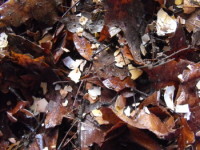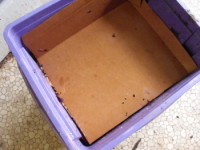
How to make a worm bin
Tomorrow,
we'll be adding dozens of new livestock to our family. Yup, it's
time for worms!!!
Mark has been trying to talk me into worms for months, but I've
resisted since I hate to take any scraps away from the chickens and I
don't like using up indoors space. (Outdoor worm bins don't work
in cold weather.) But I was won over by the promise of rich
compost tea to help our houseplants thrive, and by the free worms being
offered to us by Dennis from Florida.
The simple worm bin I built this afternoon is based loosely on Whatcom
County's Cheap and Easy Worm bin, but is only a one tray bin with a
large reservoir beneath to collect the compost tea.  Many sites recommend simply
placing the lid of
the container under your bin to collect the liquid, but that seems prone to
spillage and I want lots of
tea. Also note the air holes drilled around the sides and
in the bottom of the worm bin tray.
Many sites recommend simply
placing the lid of
the container under your bin to collect the liquid, but that seems prone to
spillage and I want lots of
tea. Also note the air holes drilled around the sides and
in the bottom of the worm bin tray.

I filled the bin halfway up with wet leaves, including a few handfuls
of dirt and eggshells, then covered the bedding with a wet piece of
cardboard. Once the worms arrive and settle in for a few days,
we'll begin to feed them. I'm looking forward to learning about
the wonders of vermiculture!
Want more in-depth information? Browse through our books.
Or explore more posts by date or by subject.
About us: Anna Hess and Mark Hamilton spent over a decade living self-sufficiently in the mountains of Virginia before moving north to start over from scratch in the foothills of Ohio. They've experimented with permaculture, no-till gardening, trailersteading, home-based microbusinesses and much more, writing about their adventures in both blogs and books.
Want to be notified when new comments are posted on this page? Click on the RSS button after you add a comment to subscribe to the comment feed, or simply check the box beside "email replies to me" while writing your comment.

What a great idea about using another container underneath! We actually started to make a worm bin a few years ago (went out and got a ruubermaid type container, drilled all the holes in it) but never got around to actually setting it up because the plans I read too said use the lid for a drainage pan and with our super tiny house, a curious toddler and curious pets the more I thought about it I could just see what a mess that would end up being and gave up on the idea. So there my poor empty "worm" bin has set collecting dust. I think I will go dust it off and find another container for drainage and get to work on it. Thanks for the inspiration!
Kim
I'm glad to hear I wasn't the only one who got stuck on the notion of putting the lid under the worm bin. I don't have a toddler, and my cat is a couch slug, but it still sounded like a disaster waiting to happen!
I've had good luck with my worm bin so far. I've been feeding the compost tea which collects in the container underneath to our houseplants and they're looking much more perky.
Anna,
I used to use the lid-on-the-bottom technique and I too was not happy with the spillage factor. So what I did was just get another bin for the bottom, one which didn't get holes drilled into it. So I have three bins - two for the rotating system and one as my compost tea collector. I may get fancy next spring and drill a hole in the bottom one so I can install a tap. Then I can put the bin up on some cinder blocks and just drain the bottom one from time to time.
By the way - ALL of your blog posts are showing up as new in my feed reader this morning, even though they are very old posts. But that's ok - I've been meaning to check the older stuff anyway.
Everett
I'm thinking of a tap, eventually, too. For now, I've just been taking the top bin off and pouring the compost tea in the bottom bin directly on my plants, but that's a bit of a pain.
Odd about your feed reader. I've subscribed to my own feed through Google Reader just to keep an eye on things, but it didn't seem to have that problem. Not sure what's up... I hope it's not too annoying.
Hello Anna and Mark,
Just found your blog a few days ago and have been reading through the archives as I have time. I've been loving it. Sorry to comment on a really old post, this stuff is just all so fascinating!
Just a note about compost tea (which you can also make with non-worm compost): It's a bit of a misnomer to call the liquid that collects under your bin "tea." Any liquid coming out of the bottom means that there is a too much moisture in the worm bin. Adding more dry bedding, and/or slowing down your feeding can help. While this liquid will certainly contain some water soluble nutrients and microbes from the compost (thus the perkiness of your plants), to get the maximum nutritional and disease prevention benefits, you need to brew the "tea" and boost the microbial population. The microbes are the key! They make all those nutrients readily available to the plants and can really boost their resistance to disease. Lots of resources online about doing this, but basically it involves steeping some amount of compost in water (I use an old pillow case as my "tea bag and suspend it in a 5-gallon bucket)," feeding the microbes (or not), and aeration (stirring frequently, or using a little fish tank oxygen pump if you're lazy like me). A day or two later you have nutrient and microbially rich compost tea! Keep up the awesome work!
Wayde --- I know that purists believe you have to aerate and add food to get compost tea, but I'm not sold on the drippings from a worm bin being any less high quality. The reason worm castings have so many benefits is because they're chock full of microorganisms, and the way I get worm tea is by pouring water on top of the worm bin to soak some nutrients and microorganisms out. Think of it as a bit like an automatic coffeemaker instead of steeping tea in a teapot...
Thanks for reading and commenting on old posts! I like seeing them pop back up!